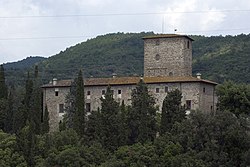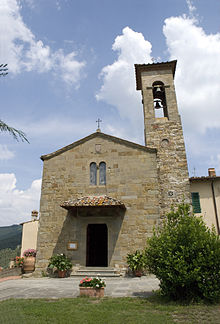| Chiocchio | ||
 | ||
| State | Italy | |
|---|---|---|
| Region | Tuscany | |
| Altitude | 286 m a.s.l. | |
| Inhabitants | 592 (2001) | |
| Name inhabitants | I chiocchiesi | |
| Prefix tel | 39 055 | |
| POSTAL CODE | 50020 | |
| Time zone | UTC 1 | |
| Patron | San Donato (October 22) | |
Position
| ||
Chiocchio is a fraction of the municipality of Greve in Chianti in the province of Florence.
To know
Chiocchio is a locality that is part of the municipality of Greve in Chianti. Its ancient name was Source al Brocco and here, in the thirteenth century, the via publicana, ridge path, from the public road, then Strata de Chianti. This route thus had a significant importance for the rural and religious settlements that arose in its vicinity: the tower-house of Fonzacchino, the oratory of San Giusto in Montemartiri, the church of San Michele in Rugliana, the Monastery of Santa Margherita in Sugame, San Lorenzo al Frassino, the Oratory of Monte Domini, Torsoli, with the churches of San Gaudenzio and San Michele.
Background
In the vicinity of the Barberino farm, a Roman-era doliar stamp was found, depicting Hercules, with Greek writing EPA, contraction of Hera (Kles), or Hercules.
How to orient yourself
In Chiocchio there is the area of Palaia, with its dirt road between vineyards and olive trees, a destination for trekking enthusiasts, but today the subject of discussion for the subdivision in progress.
How to get
By plane
- 1 Florence-Peretola Airport (Amerigo Vespucci Airport, IATA: FLR). About 27 km away, it is certainly the most convenient airport for those who have to take this means to get closer. Once you leave the airport, you can take a taxi to go to your destination or to the most convenient and cheapest public transport. There are also scooter and car rental services.
By car
The A1 motorway is the main artery that connects Greve to the rest ofItaly. Since there is no dedicated exit, for those coming from the south it is preferable to exit at "Incisa Valdarno" continuing in the direction Figline Valdarno and from there follow signs for Greve in Chianti. Those coming from the north, on the other hand, should go out at "Firenze sud" and then take the SR 222 (Chiantigiana) towards Greve in Chianti.
On the train
There are no railway stations in the municipality of Greve In Chianti. The closest railway stations are those of: Engraved in Val D'arno, Figline Valdarno, Rovezzano, Vicchio is San Piero a Sieve. Once you arrive at these stations you need to take other means of transport (taxi or bus) to get to your destination.
From the station of Florence Santa Maria Novella you can take a bus at the opposite terminus.
By bus
The most convenient way to reach Greve is via the interurban buses of the acvbus.
How to get around
What see



- 1 Parish church of San Donato in Mugnana. It stands on the land that was owned by the Bardi di Vernio. We know of it from documents of the XII century, but it was built in the year 1000. It has undergone several renovations over the years, starting from the fourteenth century, a period in which the Pieve was given a Romanesque style and, in 1934, it was rebuilt. Not far from the church there is a small cemetery which has been recently renovated.
- The church has on the outside, above the entrance portal, a lunette depicting the Madonna.
- Inside it consists of a single nave, stone altars on the side walls, along which there is also the Way of the cross, the high altar, an organ. It houses the relics of San Primo martyr and reliquaries in the sacristy. There are frescoes representing St. Francis de Sales, Santa Margherita, St. John Bosco,Saint Bernard of Clairvaux, St. Jerome, Sant'Ambrogio, San Gregorio is St. Augustine, but the author is not known; in the rectory: San Donato, St. Gregory the Great is Clement VII, works by Nicodemo Ferrucci and the Healing of the man born blind of the Sacristani. Other furnishings consist of six mirrors with a golden frame, a wooden bust of San Donato.
- The church also preserves an erratic capital with figures (deteriorated at the corners) of goats and symbolic motifs (starry flowers, palmettes).
- From this church comes a painting that is now in the church of Santa Maria a Chiocchio, a painting that was commissioned by Carlo Bardi di Vernio, man of letters, enrolled among the Academicians Apatisti and della Crusca. At the bottom of this painting is the inscription: Carolus comes Vernii donavit 1616 and, further down: Et Jacobus Pecci P.1815 restauravit. It represents the Rest of the flight into Egypt, with the Virgin sitting under the tree and the Child in her arms, Saint Joseph leaning against a low wall; the background is represented by monuments, columns, while in the foreground you can see a basket with cloths. This painting is a copy of the Holy Family by Andrea del Sarto which is located in the Barberini Gallery of Rome and is attributed to the School Tuscany.
- In the Pieve di San Donato in Mugnana there are a thurible and a small boat from the Abbey of San Cassiano in Montescalari.
- Church of Santa Maria (former Church of the Madonna del Buon Viaggio). Keep the painting, coming from the Pieve, Rest from the escape in Egypt, of the school Tuscany (1616).
- Mugnana Castle. In the 14th century the castle of Mugnana, whose previous owners were the Amidei, became the property of the Florentine Bardi family. This castle was part of the ancient League of Cintoia. Its tower was originally about sixty meters high, but was later reduced for military reasons. Its construction and also that of the walls dates back to the years preceding the fourteenth century.
- The castle was damaged by the Aragonese allies of Siena in the war against Florence (1530) and, in 1890, due to an earthquake. Its walls, in the center of which there is the keep (whose construction dates back to the second half of the thirteenth century), have had many restorations.
- In the courtyard of the castle there is a loggia with octagonal pillars - with Gothic characters - in pietra serena that support the stone masonry.


- 2 Villa Brody. The villa stands isolated on the top of a hill near the town of Chiocchio, in the Florentine Chianti area and presents the peculiarity of the arrangement opposite to the course of the slope.
- Of longitudinal layout, it is in fact placed almost cantilevered on the hill, so that each of its two floors rests on the ground with one end to detach from the other, projecting towards the valley and entering into direct relationship with the space beyond the hill itself.
- It is surrounded by a plot of land arranged as a meadow, bordered upstream, on via Palaia, by a thick hedge cut in the center by the gate leading to the property; on the other sides the area is instead closed by a wooded enclosure which protects the building from the street and which in turn excludes the unfortunate construction of the nearby urban nucleus from the wide visual glimpses that can be enjoyed from the villa itself.

